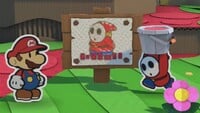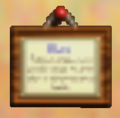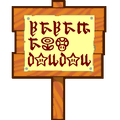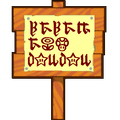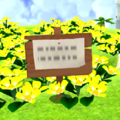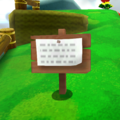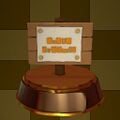User:Nintendo101/flowerpot: Difference between revisions
Nintendo101 (talk | contribs) |
Nintendo101 (talk | contribs) mNo edit summary |
||
| Line 7: | Line 7: | ||
{{quote2|To read a sign, stand in front of it and press B, like you did just now.|Sign in the [[Bob-omb Battlefield]]|[[Super Mario 64]]}} | {{quote2|To read a sign, stand in front of it and press B, like you did just now.|Sign in the [[Bob-omb Battlefield]]|[[Super Mario 64]]}} | ||
''' | '''Signs''',<ref>{{cite|author=[[Nintendo of America]]|date=1996|title=''Super Mario 64 Instruction Booklet''|format=PDF|url=https://m1.nintendo.net/docvc/NUS/USA/NSME/NSME_E.pdf|location=Redmond|publisher=Nintendo of America|page=8}}</ref><ref>{{cite|author=[[Nintendo of America]]|date=2005|title=''Super Mario 64 DS Instruction Booklet''|location=Redmond|publisher=Nintendo of America|page=13}}</ref><ref>{{cite|quote=While standing in front of certain characters or signs, you can press {{button|wii|a}} to speak or read.|author=[[Nintendo of America]]|date=2007|title=''Super Mario Galaxy Instruction Booklet''|format=PDF|url=https://csassets.nintendo.com/noaext/image/private/t_KA_PDF/Wii_Super_Mario_Galaxy?_a=BATCtdAA0|location=Redmond|publisher=Nintendo of America|page=13}}</ref><ref>{{cite|author=[[Nintendo|Nintendo of Europe]]|date=2012|title=''Paper Mario: Sticker Star''|format=electronic manual|url=https://cdn02.nintendo-europe.com/media/downloads/games_8/emanuals/nintendo_3ds_2/paper_mario_sticker_star/ElectronicManual_Nintendo3DS_PaperMarioStickerStar_EN.pdf|location=Großostheim|publisher=Nintendo of Europe|page=8}}</ref><ref>{{cite|quote=A classic wooden sign. Useful for conveying information and only occasionally snarkily.|author=Collectible Treasure description in the [[Musée Champignon]]|date=2020|title=''[[Paper Mario: The Origami King]]'' by [[Intelligent Systems]]|format=North American localization|location=Redmond|publisher=[[Nintendo of America]]}}</ref> or '''signboards''',<ref>{{cite|quote=I see...a Close Call Badge. Near the signboard located on the path from Goomba Village to Toad Town, you see a red Block. When you smash it from below, the Badge appears.|author=[[Merluvlee]]|date=2001|title=''[[Paper Mario]]'' by [[Intelligent Systems]]|format=North American localization|location=Redmond|publisher=[[Nintendo of America]]}}</ref><ref>{{cite|quote=Stand in front of certain characters and press the A Button to talk to them, or stand in front of signboards and press the A Button to read them.|author=[[Nintendo|Nintendo of Europe]]|date=2010|title=''Super Mario Galaxy 2 Instruction Booklet''|format=PDF|url=https://m1.nintendo.net/docvc/RVL/EUR/SB4P/SB4P_E.pdf|location=Großostheim|publisher=Nintendo of Europe|page=18}}</ref> are bulletins in the [[Super Mario (franchise)|''Super Mario'' franchise]] that debuted in ''[[Super Mario 64]]''. In all appearances, a sign provides information on an available action or the current level when prompted. Signs are either staked into the ground like [[Stump|post]]s or fastened to the side of walls. Staked signs have a secondary interactive element in a few games. They are comparable to [[Message Block]]s. | ||
The player is rarely obligated to read | The player is rarely obligated to read signs. Rather, they are available at their discretion. In ''[[Super Mario Galaxy]]'' and ''[[Super Mario Galaxy 2]]'', there are a few boards that are [[Boards (characters)|conscious, speaking characters]] that do impose themselves onto the player character when encountered. | ||
==History== | ==History== | ||
| Line 30: | Line 30: | ||
====''Super Mario Galaxy 2''==== | ====''Super Mario Galaxy 2''==== | ||
Nearly all of the | Nearly all of the signboards in ''[[Super Mario Galaxy 2]]'' are presented as inanimate objects. The only character from the previous game to return is Bill Board. However, there are a few instances where simply being near a signboard causes a small dialogue box to appear above it, suggesting they are "calling out" to the player character. While their physical appearances are largely unchanged, signboards have more lines of text on the page nailed to their exterior than they did in ''Super Mario Galaxy''. | ||
====''Super Mario Odyssey''==== | ====''Super Mario Odyssey''==== | ||
Signs, | Signs, here referred to as '''Travel Tips''', appear throughout ''[[Super Mario Odyssey]]''. It is the first 3D game in the [[Super Mario (series)|''Super Mario'' series]] to include these signs in seven years. Most Travel Tips only inform the player an action available to [[Mario]] and/or [[Cappy]]. Environmental details are instead available in the visited kingdom's brochure, while hints on course progression are in the names of the [[mission|objective]]s and can be relayed by [[Hint Toad]], [[Talkatoo]], and [[Uncle amiibo]]. However, the Travel Tip found by [[Yoshi's House]] was directly written by [[Yoshi|him]]. After a Travel Tip is read, an animation of the described action being performed appears in the bottom right of the screen. | ||
Unlike previous titles, Travel Tips are made of metal in ''Super Mario Odyssey''. Like [[Arrow Sign]]s, staked Travel Tips spin when struck by Cappy. They otherwise appear fastened to the sides of terrain. | Unlike previous titles, Travel Tips are made of metal in ''Super Mario Odyssey''. Like [[Arrow Sign]]s, staked Travel Tips spin when struck by Cappy. They otherwise appear fastened to the sides of terrain. | ||
====''Super Mario Bros. Wonder''==== | ====''Super Mario Bros. Wonder''==== | ||
Signs appear in ''[[Super Mario Bros. Wonder]]'', a 2D game that saw involvement from [[Nintendo EPD]] staff typically involved with the 3D ones.<ref>{{cite|author=[[Nintendo]]|title=Super Mario Bros. Wonder—Part 3|url=https://www.nintendo.com/us/whatsnew/ask-the-developer-vol-11-super-mario-bros-wonder-part-3/|date=18 Oct. 2023|publisher=Ask the Developer Vol. 11}}</ref> This is their first appearance in a 2D ''Super Mario'' title. Signs only appear in the overworld map of the [[Flower Kingdom]] and relay information about the overworld itself. As in ''Super Mario Odyssey'', they are depicted here as metal. At least one sign is posted in each [[world]]. | |||
===''Paper Mario'' series=== | ===''Paper Mario'' series=== | ||
| Line 58: | Line 56: | ||
====''Paper Mario: Color Splash''==== | ====''Paper Mario: Color Splash''==== | ||
[[File:PaintGuyCloseUp.jpg|200px|thumb|The Paint Guy splayed on a sign in Ruddy Road, near the Paint Guy | [[File:PaintGuyCloseUp.jpg|200px|thumb|The Paint Guy splayed on a sign in Ruddy Road, near the Paint Guy themselves.]] | ||
In ''[[Paper Mario: Color Splash]]'', signs occur throughout [[Prism Island]] and provide information on the visited area when the player presses {{button|wiiu|a}}. On [[Ruddy Road]], several signs warn of a [[Ruddy Road Paint Guy|thieving Paint Guy]]. They conceals themselves on one of them towards the end of the area. Striking the sign with a [[hammer]] forces the Paint Guy to fall off. | In ''[[Paper Mario: Color Splash]]'', signs occur throughout [[Prism Island]] and provide information on the visited area when the player presses {{button|wiiu|a}}. On [[Ruddy Road]], several signs warn of a [[Ruddy Road Paint Guy|thieving Paint Guy]]. They conceals themselves on one of them towards the end of the area. Striking the sign with a [[hammer]] forces the Paint Guy to fall off. | ||
| Line 66: | Line 64: | ||
===''Mario & Luigi'' series=== | ===''Mario & Luigi'' series=== | ||
====''Mario & Luigi: Superstar Saga'' / ''Mario & Luigi: Superstar Saga + Bowser's Minions''==== | ====''Mario & Luigi: Superstar Saga'' / ''Mario & Luigi: Superstar Saga + Bowser's Minions''==== | ||
Bulletin boards and posted signs appear throughout ''[[Mario & Luigi: Superstar Saga]]'' and its [[Mario & Luigi: Superstar Saga + Bowser's Minions|Nintendo 3DS remake]]. The provide information on the visited area and hint towards potential actions. The bulletin board in [[Toad Town#Mario & Luigi: Superstar Saga / Mario & Luigi: Superstar Saga + Bowser's Minions|Toadtown Square]] displays the ''[[Kingdom Courier]]''. | |||
Like most field elements, only [[Mario]] can interact with signs in the [[Mario & Luigi (series)|''Mario & Luigi'' series]]. In ''Superstar Saga'', this is done by pressing the primary action button ({{button|gba|a}}, {{button|gcn|a}}, or {{button|3ds|a}}, depending on the console and version). | |||
====''Mario & Luigi: Partners in Time''==== | ====''Mario & Luigi: Partners in Time''==== | ||
The signs in ''[[Mario & Luigi: Partners in Time]]'' provide information on the currently visited area. Mario reads one by pressing {{button|ds|a}}. The warning on the sign outside [[Thwomp Volcano]] needs to be ignored to progress through the area. | |||
====''Mario & Luigi: Bowser's Inside Story'' / ''Mario & Luigi: Bowser's Inside Story + Bowser Jr.'s Journey''==== | ====''Mario & Luigi: Bowser's Inside Story'' / ''Mario & Luigi: Bowser's Inside Story + Bowser Jr.'s Journey''==== | ||
| Line 95: | Line 95: | ||
SMG2 Screenshot Board.png|''[[Super Mario Galaxy 2]]'' | SMG2 Screenshot Board.png|''[[Super Mario Galaxy 2]]'' | ||
PMSS-Water Edge Way Secret.png|''[[Paper Mario: Sticker Star]]'' | PMSS-Water Edge Way Secret.png|''[[Paper Mario: Sticker Star]]'' | ||
PMCS Cherry Lake cutout 3.png|''[[Paper Mario: Color Splash]]'' | |||
PMTOK Battle Lab.jpg|''[[Paper Mario: The Origami King]]'' | PMTOK Battle Lab.jpg|''[[Paper Mario: The Origami King]]'' | ||
PMTOK Collectible Treasure 35 (Sign).jpg|''Paper Mario: The Origami King'' (Collectible Treasure) | |||
</gallery> | </gallery> | ||
Revision as of 16:51, May 3, 2024
| flowerpot | |
|---|---|
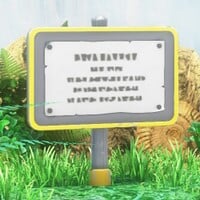 Screenshot from Super Mario Odyssey | |
| First appearance | Super Mario 64 (1996) |
| Latest appearance | Super Mario Bros. Wonder (2023) |
| Effect | Provides information when read. |
Signs,[1][2][3][4][5] or signboards,[6][7] are bulletins in the Super Mario franchise that debuted in Super Mario 64. In all appearances, a sign provides information on an available action or the current level when prompted. Signs are either staked into the ground like posts or fastened to the side of walls. Staked signs have a secondary interactive element in a few games. They are comparable to Message Blocks.
The player is rarely obligated to read signs. Rather, they are available at their discretion. In Super Mario Galaxy and Super Mario Galaxy 2, there are a few boards that are conscious, speaking characters that do impose themselves onto the player character when encountered.
History
Super Mario series
Super Mario 64 / Super Mario 64 DS
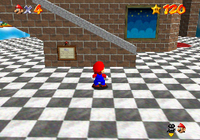
Signs can be read by the player character in Super Mario 64 and Super Mario 64 DS by pressing ![]() on the Nintendo 64 Controller or
on the Nintendo 64 Controller or ![]() on the Nintendo DS system, respectively. It is the same input used by the player to speak with a non-playable character. Signs compensate for the diversity of moves the developers included in the game and provide context for players who may be lost.
on the Nintendo DS system, respectively. It is the same input used by the player to speak with a non-playable character. Signs compensate for the diversity of moves the developers included in the game and provide context for players who may be lost.
Typically, signs provide information on a move the player can perform or contextualize a potentially cryptic detail in the environment. The signs that are staked into the ground can be ground-pounded by the player character, rendering it unreadable unless they exit and reenter the course. Like stakes, it takes Mario three strikes to fully bury the sign. This is the case for Luigi and Yoshi in Super Mario 64 DS as well. It takes Wario only one. Signs otherwise occur pinned to walls and can only be read.
Some of the text on signs were written by other characters in the game, such as the Big Bob-omb, a Big Penguin, and a Piranha Plant. Ukikipedia has fully documented all lines of text displayed on the signs and the locality of each one. Their list can be viewed here.
Super Mario Sunshine
Only staked signs appear in Super Mario Sunshine. The player can read one by pressing ![]() . Signs do not present tips on actions or progression, instead relaying episode-specific information about the active stage. The details written on some signs changes depending on the active episode, such as the one in front of the Surf Cabana on Gelato Beach. Unlike Super Mario 64, signs have no secondary interactive component to them. In the original Japanese release, English text is displayed on signs. It is replaced with the original language of Isle Delfino in the North American localization.
. Signs do not present tips on actions or progression, instead relaying episode-specific information about the active stage. The details written on some signs changes depending on the active episode, such as the one in front of the Surf Cabana on Gelato Beach. Unlike Super Mario 64, signs have no secondary interactive component to them. In the original Japanese release, English text is displayed on signs. It is replaced with the original language of Isle Delfino in the North American localization.
Super Mario Galaxy
Staked signs appear throughout Super Mario Galaxy and are read when the player presses ![]() . Like prior appearances, nearly all signs are inanimate objects that the player choses to engage with. However, a few speaking board characters impose themselves in scenarios where the player character's controls are different from usual. For example, the first one, Bill Board, appears in the Rolling Green Galaxy where Mario (or Luigi) can only traverse platforms on the Rolling Ball.
. Like prior appearances, nearly all signs are inanimate objects that the player choses to engage with. However, a few speaking board characters impose themselves in scenarios where the player character's controls are different from usual. For example, the first one, Bill Board, appears in the Rolling Green Galaxy where Mario (or Luigi) can only traverse platforms on the Rolling Ball.
As in Super Mario Sunshine, signs lack secondary interactive elements, though one in the Ghostly Galaxy is written in Booish and can only be read if the player character is in their Boo form.
Super Mario Galaxy 2
Nearly all of the signboards in Super Mario Galaxy 2 are presented as inanimate objects. The only character from the previous game to return is Bill Board. However, there are a few instances where simply being near a signboard causes a small dialogue box to appear above it, suggesting they are "calling out" to the player character. While their physical appearances are largely unchanged, signboards have more lines of text on the page nailed to their exterior than they did in Super Mario Galaxy.
Super Mario Odyssey
Signs, here referred to as Travel Tips, appear throughout Super Mario Odyssey. It is the first 3D game in the Super Mario series to include these signs in seven years. Most Travel Tips only inform the player an action available to Mario and/or Cappy. Environmental details are instead available in the visited kingdom's brochure, while hints on course progression are in the names of the objectives and can be relayed by Hint Toad, Talkatoo, and Uncle amiibo. However, the Travel Tip found by Yoshi's House was directly written by him. After a Travel Tip is read, an animation of the described action being performed appears in the bottom right of the screen.
Unlike previous titles, Travel Tips are made of metal in Super Mario Odyssey. Like Arrow Signs, staked Travel Tips spin when struck by Cappy. They otherwise appear fastened to the sides of terrain.
Super Mario Bros. Wonder
Signs appear in Super Mario Bros. Wonder, a 2D game that saw involvement from Nintendo EPD staff typically involved with the 3D ones.[8] This is their first appearance in a 2D Super Mario title. Signs only appear in the overworld map of the Flower Kingdom and relay information about the overworld itself. As in Super Mario Odyssey, they are depicted here as metal. At least one sign is posted in each world.
Paper Mario series
Paper Mario
In Paper Mario, the Talk icon appears above an approached signboard as if it were a non-playable character. Pressing ![]() displays the text. A small star icon appears in the button right of a textbox when their are multiple pages. Pressing
displays the text. A small star icon appears in the button right of a textbox when their are multiple pages. Pressing ![]() again turns to the next page.
again turns to the next page.
A message board near Merlon's house displays Toad Town News. The contents of the board change depending on what the active chapter is.
Paper Mario: The Thousand-Year Door
Signs are read by pressing ![]() . Like the first Paper Mario, signs convey details on the surrounding environment and the names for important locations in Paper Mario: The Thousand-Year Door and its Nintendo Switch remake. The pages nailed to signs are written in an original syllabary.
. Like the first Paper Mario, signs convey details on the surrounding environment and the names for important locations in Paper Mario: The Thousand-Year Door and its Nintendo Switch remake. The pages nailed to signs are written in an original syllabary.
Super Paper Mario
Signs have the same design and purpose in Super Paper Mario that they had in The Thousand-Year Door, providing details on surrounding area and tips on progression. However, they sometimes are cryptic in themselves. For example, a sign in The Bitlands displays its text backwards.
Paper Mario: Sticker Star
Signs occur throughout stages in Paper Mario: Sticker Star, providing information on the surrounding area. In some areas, they denote the name of a nearby structure. One can be read when the player presses . A Mushroom encircled by a green spot appears on every sign.
Paper Mario: Color Splash
In Paper Mario: Color Splash, signs occur throughout Prism Island and provide information on the visited area when the player presses ![]() . On Ruddy Road, several signs warn of a thieving Paint Guy. They conceals themselves on one of them towards the end of the area. Striking the sign with a hammer forces the Paint Guy to fall off.
. On Ruddy Road, several signs warn of a thieving Paint Guy. They conceals themselves on one of them towards the end of the area. Striking the sign with a hammer forces the Paint Guy to fall off.
Paper Mario: The Origami King
Signs provide info on visited areas in Paper Mario: The Origami King and the can be read when the player presses . A Collectible Treasure of a sign is hidden in the Chestnut Valley. Signs inherit the design they had in Color Splash.
Mario & Luigi series
Mario & Luigi: Superstar Saga / Mario & Luigi: Superstar Saga + Bowser's Minions
Bulletin boards and posted signs appear throughout Mario & Luigi: Superstar Saga and its Nintendo 3DS remake. The provide information on the visited area and hint towards potential actions. The bulletin board in Toadtown Square displays the Kingdom Courier.
Like most field elements, only Mario can interact with signs in the Mario & Luigi series. In Superstar Saga, this is done by pressing the primary action button (![]() ,
, ![]() , or
, or , depending on the console and version).
Mario & Luigi: Partners in Time
The signs in Mario & Luigi: Partners in Time provide information on the currently visited area. Mario reads one by pressing ![]() . The warning on the sign outside Thwomp Volcano needs to be ignored to progress through the area.
. The warning on the sign outside Thwomp Volcano needs to be ignored to progress through the area.
Mario & Luigi: Bowser's Inside Story / Mario & Luigi: Bowser's Inside Story + Bowser Jr.'s Journey
dunno
Mario & Luigi: Dream Team
dunno
Mario & Luigi: Paper Jam
dunno
Gallery
Names in other languages
| Language | Name | Meaning |
|---|---|---|
| Japanese | Kanban 看板[13] Kanban |
Signboard - |
| French | Affiche[14] |
Poster |
| Spanish | Signo[15] |
Sign |
See also
References
- ^ Nintendo of America (1996). Super Mario 64 Instruction Booklet (PDF). Redmond: Nintendo of America. Page 8.
- ^ Nintendo of America (2005). Super Mario 64 DS Instruction Booklet. Redmond: Nintendo of America. Page 13.
- ^ "While standing in front of certain characters or signs, you can press
 to speak or read." – Nintendo of America (2007). Super Mario Galaxy Instruction Booklet (PDF). Redmond: Nintendo of America. Page 13.
to speak or read." – Nintendo of America (2007). Super Mario Galaxy Instruction Booklet (PDF). Redmond: Nintendo of America. Page 13.
- ^ Nintendo of Europe (2012). Paper Mario: Sticker Star (electronic manual). Großostheim: Nintendo of Europe. Page 8.
- ^ "A classic wooden sign. Useful for conveying information and only occasionally snarkily." – Collectible Treasure description in the Musée Champignon (2020). Paper Mario: The Origami King by Intelligent Systems (North American localization). Redmond: Nintendo of America.
- ^ "I see...a Close Call Badge. Near the signboard located on the path from Goomba Village to Toad Town, you see a red Block. When you smash it from below, the Badge appears." – Merluvlee (2001). Paper Mario by Intelligent Systems (North American localization). Redmond: Nintendo of America.
- ^ "Stand in front of certain characters and press the A Button to talk to them, or stand in front of signboards and press the A Button to read them." – Nintendo of Europe (2010). Super Mario Galaxy 2 Instruction Booklet (PDF). Großostheim: Nintendo of Europe. Page 18.
- ^ Nintendo (18 Oct. 2023). Super Mario Bros. Wonder—Part 3. Ask the Developer Vol. 11.
- ^ Nintendo Co., Ltd. (1997). 『Super Mario 64 振動パック対応バージョン
取扱説明書 』 (PDF). Tokyo: Nintendo Co., Ltd. (Japanese). Page 8. - ^ Nintendo Co., Ltd. (2004). 『Super Mario 64 DS
取扱説明書 』 (PDF). Tokyo: Nintendo Co., Ltd. (Japanese). Page 11. - ^ Nintendo Co., Ltd. (2007). 『Super Mario Galaxy
取扱説明書 』 (PDF). Tokyo: Nintendo Co., Ltd. (Japanese). Page 16. - ^ Nintendo Co., Ltd. (2010). 『Super Mario Galaxy 2
取扱説明書 』 (PDF). Tokyo: Nintendo Co., Ltd. (Japanese). Page 18. - ^ Sakai, Kazuya (Ambit), kikai, Akinori Sao, Junko Fukuda, Kunio Takayama, and Ko Nakahara (Shogakukan), editors (2015). 『スーパーマリオブラザーズ百科: 任天堂公式ガイドブック』. Tokyo: Shogakukan (Japanese). Page 105, 136, 169.
- ^ Nintendo of America (2007). Super Mario Galaxy Instruction Booklet (PDF). Redmond: Nintendo of America (French). Page 35.
- ^ Nintendo of America (2007). Super Mario Galaxy Instruction Booklet (PDF). Redmond: Nintendo of America (Spanish). Page 57.
